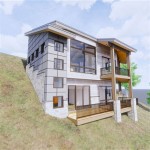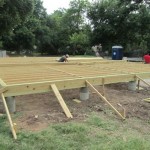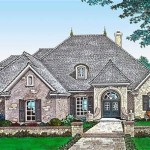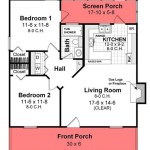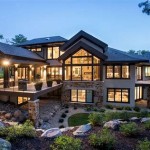A Shotgun House Plan is a simple, rectangular building template often seen in urban areas, primarily in the United States. It is characterized by its long, narrow shape, with rooms arranged in a straight line from the front door to the back door, without any hallways. This design provides a direct path through the house, allowing for easy flow of air and light.
Shotgun House Plans were initially popularized in New Orleans during the late 1800s. They were commonly constructed as small, single-story homes for working-class families and shotgun house communities quickly spread throughout the southern United States. Due to its low cost and easy construction, the shotgun house plan remained popular through the early 20th century and can still be found in many older neighborhoods today.
In the following sections, we will delve into the history, design principles, and modern applications of Shotgun House Plans, exploring their cultural significance and enduring appeal.
Shotgun House Plans are characterized by several key features:
- Long, Narrow Shape
- Rooms Aligned in a Straight Line
- No Hallways
- Front and Back Doors Aligned
- Natural Ventilation and Light
- Compact and Efficient Design
- Typically Single-Story
- Often Found in Urban Areas
- Historically Associated with Working-Class Families
These design principles contribute to the Shotgun House Plan’s functionality and affordability, making it a popular choice for many homeowners.
Long, Narrow Shape
The long, narrow shape of Shotgun House Plans is a defining characteristic that contributes to their unique functionality and spatial arrangement. This shape typically results in a rectangular footprint, with the front and back doors aligned on opposite ends of the house. The narrow width, usually ranging from 12 to 14 feet, allows for efficient use of space and natural ventilation.
The long, narrow shape also dictates the arrangement of rooms within the house. Rooms are typically arranged in a linear fashion, one after the other, without any hallways. This creates a direct path from the front to the back of the house, allowing for easy movement and flow of air. The absence of hallways also maximizes the usable space within the house, making it feel more spacious than its actual size.
Furthermore, the long, narrow shape promotes cross-ventilation, a passive cooling technique that utilizes natural breezes to circulate air through the house. With windows and doors placed on opposite sides of the house, air can easily flow from front to back, creating a comfortable and well-ventilated living environment.
Overall, the long, narrow shape of Shotgun House Plans is not only a defining aesthetic feature but also a functional design element that contributes to the house’s efficiency, livability, and overall charm.
Rooms Aligned in a Straight Line
One of the defining characteristics of Shotgun House Plans is that the rooms are aligned in a straight line, from the front door to the back door. This linear arrangement is a direct result of the long, narrow shape of the house and plays a significant role in its functionality and spatial organization.
The alignment of rooms in a straight line creates a clear and efficient path through the house, allowing for easy movement and flow of air. Without any hallways or corridors, the space is maximized, and the house feels more spacious than its actual size. The direct line of sight from the front door to the back door also provides a sense of openness and connectivity, making the house feel more inviting and less cramped.
Furthermore, the linear arrangement of rooms promotes cross-ventilation, a passive cooling technique that utilizes natural breezes to circulate air through the house. With windows and doors placed on opposite sides of the house, air can easily flow from front to back, creating a comfortable and well-ventilated living environment. This is particularly beneficial in warm climates, where natural ventilation is essential for maintaining a comfortable indoor temperature.
Additionally, the alignment of rooms in a straight line simplifies the layout and construction of the house. By eliminating hallways and complex room configurations, the design becomes more straightforward and cost-effective to build. This simplicity also makes it easier to modify or expand the house in the future, as additional rooms can be added to the end of the linear sequence without compromising the overall design.
In summary, the alignment of rooms in a straight line in Shotgun House Plans is not only a defining aesthetic feature but also a functional design element that contributes to the house’s efficiency, livability, and cost-effectiveness.
No Hallways
One of the most distinctive features of Shotgun House Plans is the absence of hallways. This design choice not only contributes to the house’s overall efficiency but also has several practical and aesthetic benefits.
Efficient Use of Space: By eliminating hallways, Shotgun House Plans maximize the usable space within the house. Every square foot is dedicated to living space, making the house feel more spacious and comfortable. The of hallways also reduces wasted space, making the house more affordable to build and maintain.
Improved Airflow and Natural Light: The absence of hallways promotes better airflow and natural light penetration throughout the house. With no barriers to impede the flow of air, breezes can easily circulate from the front to the back of the house, creating a more comfortable and healthier living environment. Natural light can also penetrate deeper into the house, reducing the need for artificial lighting and creating a more inviting atmosphere.
Simplified Circulation: The of hallways simplifies circulation within the house, making it easier to move from one room to another. The direct line of sight from the front door to the back door provides a clear path through the house, reducing the likelihood of getting lost or disoriented.
Enhanced Connectivity: The of hallways also enhances the connectivity between the different rooms in the house. Without physical barriers separating the spaces, there is a greater sense of openness and togetherness. This can be particularly beneficial for families with children or for those who enjoy entertaining guests.
In addition to these practical benefits, the of hallways in Shotgun House Plans also contributes to their unique aesthetic appeal. The open and airy layout creates a sense of flow and spaciousness that is often lacking in more traditional house designs. The absence of hallways also allows for greater flexibility in furniture placement and room configuration, giving homeowners more freedom to personalize their living space.
Front and Back Doors Aligned
Shotgun House Plans are characterized by the alignment of the front and back doors on opposite ends of the house. This alignment is not merely a design quirk but serves several important functional and practical purposes.
Cross-Ventilation: The alignment of the front and back doors facilitates cross-ventilation, a passive cooling technique that utilizes natural breezes to circulate air through the house. With windows and doors placed on opposite sides of the house, air can easily flow from front to back, creating a comfortable and well-ventilated living environment. This is particularly beneficial in warm climates, where natural ventilation is essential for maintaining a comfortable indoor temperature.
Natural Light Penetration: The alignment of the front and back doors also allows for greater penetration of natural light into the house. With no obstructions blocking the path of light, natural light can reach deep into the interior of the house, reducing the need for artificial lighting and creating a more inviting and cheerful atmosphere.
Clear Path of Circulation: The alignment of the front and back doors provides a clear and direct path of circulation through the house. Without any hallways or obstacles, it is easy to move from one end of the house to the other, making the house feel more spacious and accessible.
Enhanced Connectivity: The alignment of the front and back doors enhances the connectivity between the different rooms in the house. With a clear line of sight from the front to the back, there is a greater sense of openness and togetherness. This can be particularly beneficial for families with children or for those who enjoy entertaining guests.
Natural Ventilation and Light
Shotgun House Plans are renowned for their excellent natural ventilation and light penetration, which contribute significantly to the comfort and livability of the house.
- Cross-Ventilation: Shotgun House Plans are designed to facilitate cross-ventilation, a passive cooling technique that utilizes natural breezes to circulate air through the house. With windows and doors placed on opposite sides of the house, air can easily flow from front to back, creating a comfortable and well-ventilated living environment. This is particularly beneficial in warm climates, where natural ventilation is essential for maintaining a comfortable indoor temperature.
- Abundant Natural Light: The alignment of the front and back doors and the absence of hallways allow for greater penetration of natural light into the house. With no obstructions blocking the path of light, natural light can reach deep into the interior of the house, reducing the need for artificial lighting and creating a more inviting and cheerful atmosphere.
- Improved Air Quality: The efficient airflow in Shotgun House Plans helps to improve indoor air quality by removing stale air and bringing in fresh air from the outside. This can help to reduce the presence of allergens, pollutants, and moisture, creating a healthier living environment.
- Reduced Energy Consumption: The reliance on natural ventilation and light in Shotgun House Plans can help to reduce energy consumption. By minimizing the use of artificial lighting and air conditioning, homeowners can save money on their energy bills while also reducing their environmental impact.
Overall, the natural ventilation and light in Shotgun House Plans contribute to a more comfortable, healthy, and energy-efficient living environment, making them a desirable choice for many homeowners.
Compact and Efficient Design
Shotgun House Plans are renowned for their compact and efficient design, which makes them well-suited for urban areas and for homeowners who value space optimization.
Minimal Space Wastage: Shotgun House Plans are designed to minimize space wastage by eliminating unnecessary hallways and corridors. The linear arrangement of rooms and the absence of hallways maximize the usable space within the house, making it feel more spacious and comfortable. Every square foot is dedicated to living space, ensuring that the house is both functional and efficient.
Multi-Functional Spaces: Shotgun House Plans often incorporate multi-functional spaces to further enhance space utilization. For example, the living room may also serve as a dining area, or the kitchen may include a breakfast nook. By combining functions within a single space, Shotgun House Plans create a more efficient and cohesive living environment.
Built-In Storage: Many Shotgun House Plans incorporate built-in storage solutions to maximize space utilization and maintain a clutter-free environment. Built-in shelves, cabinets, and closets are often integrated into the walls and other structural elements of the house, providing ample storage space without taking up valuable floor space.
Small Footprint: Shotgun House Plans typically have a small footprint, making them ideal for narrow urban lots. The long, narrow shape of the house allows it to fit on lots that may be too small for more traditional house designs. This compact footprint also reduces the cost of land and construction, making Shotgun House Plans a more affordable option for many homeowners.
Overall, the compact and efficient design of Shotgun House Plans makes them a smart choice for homeowners who value space optimization, functionality, and affordability.
Typically Single-Story
Shotgun House Plans are typically designed as single-story structures, offering several advantages over multi-story houses.
Accessibility and Convenience: Single-story Shotgun House Plans provide easy accessibility and convenience for all occupants, regardless of age or physical ability. With everything located on one level, there are no stairs to climb, making it easier to move around the house and reducing the risk of accidents. This accessibility is particularly beneficial for families with young children, elderly individuals, or those with mobility impairments.
Efficient Space Utilization: Single-story Shotgun House Plans promote efficient space utilization by eliminating the need for staircases and hallways, which can take up valuable square footage in multi-story houses. The absence of these vertical elements allows for a more efficient layout of rooms and a better use of the available space.
Reduced Construction Costs: Building a single-story Shotgun House Plan is typically more cost-effective than constructing a multi-story house. The simpler design, with its limited number of structural elements and reduced labor requirements, can result in significant savings on construction costs.
Natural Light and Ventilation: Single-story Shotgun House Plans facilitate better natural light penetration and ventilation throughout the house. With windows and doors placed along the length of the house, natural light can reach all areas of the interior, reducing the need for artificial lighting. Additionally, the linear arrangement of rooms promotes cross-ventilation, allowing for a constant flow of fresh air through the house.
Overall, the single-story design of Shotgun House Plans offers a number of advantages, including accessibility, efficient space utilization, reduced construction costs, and improved natural light and ventilation. These factors contribute to the practicality, affordability, and overall livability of Shotgun House Plans, making them a popular choice for homeowners.
Often Found in Urban Areas
Shotgun House Plans are commonly found in urban areas, particularly in older neighborhoods and historic districts. This prevalence can be attributed to several factors:
Compact Footprint: The long, narrow shape and small footprint of Shotgun House Plans make them well-suited for narrow urban lots, which are often found in densely populated areas. This compact design allows for efficient use of land and reduces the cost of purchasing a lot in urban areas, where land prices tend to be higher.
Affordability and Value: Shotgun House Plans are generally more affordable to build and maintain than larger, more complex house designs. The simple design and efficient use of space result in lower construction and maintenance costs, making Shotgun House Plans an attractive option for homeowners on a budget. Additionally, the historic significance and architectural charm of Shotgun House Plans can increase their value over time, making them a worthwhile investment.
Historical and Cultural Significance: Shotgun House Plans have a rich historical and cultural significance, particularly in the southern United States. They were initially popularized in New Orleans during the late 1800s and quickly spread throughout the region. Today, Shotgun House Plans are recognized as an important part of the architectural heritage of many urban areas, and they are often protected by historic preservation ordinances.
Community and Neighborhood Cohesion: Shotgun House Plans often contribute to a sense of community and neighborhood cohesion. The close proximity of houses and the shared architectural style can foster a sense of belonging and shared identity among residents. Additionally, the often-narrow streets and sidewalks associated with Shotgun House neighborhoods can encourage pedestrian activity and social interaction, further strengthening community ties.
In summary, Shotgun House Plans are often found in urban areas due to their compact footprint, affordability, historical and cultural significance, and ability to foster community cohesion. These factors make Shotgun House Plans a popular choice for homeowners in densely populated urban environments.
Historically Associated with Working-Class Families
Shotgun House Plans have a strong historical association with working-class families, particularly in the southern United States. This association can be attributed to several key factors:
- Affordability: Shotgun House Plans are relatively inexpensive to build and maintain, making them an affordable option for working-class families. The simple design, efficient use of space, and modest material requirements result in lower construction and maintenance costs.
- Compact Footprint: Shotgun House Plans have a small footprint, allowing them to fit on narrow urban lots that were often available in working-class neighborhoods. This compact design maximized the use of land and reduced the cost of purchasing a lot.
- Multi-Functional Spaces: Shotgun House Plans often incorporate multi-functional spaces to accommodate the needs of growing families. For example, the living room may also serve as a dining area, or the kitchen may include a breakfast nook. This efficient use of space allowed families to make the most of their limited living area.
- Community and Neighborhood Cohesion: Shotgun House neighborhoods often fostered a sense of community and neighborhood cohesion. The close proximity of houses and the shared architectural style created a sense of belonging and shared identity among residents. Additionally, the often-narrow streets and sidewalks associated with Shotgun House neighborhoods encouraged pedestrian activity and social interaction, further strengthening community ties.
Overall, the affordability, compact footprint, multi-functional spaces, and community-oriented design of Shotgun House Plans made them an ideal housing option for working-class families in the late 19th and early 20th centuries.










Related Posts

